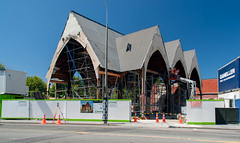
Search
Images for new Press Building; more images...
Soon be No More!
Images, eqnz.chch.2010
The former Government Life building in Christchurch's Cathedral Square will be demolished. On my walk around the city May 21, 2014 Christchurch New Zealand. www.stuff.co.nz/the-press/news/christch...
Men up High
Images, eqnz.chch.2010
On a walk around the neighbourhood, December 3, 2013, Christchurch New Zealand. www.stuff.co.nz/the-press/christchurch-life/avenues/featu...
Well Under Way
Images, eqnz.chch.2010
Knox Church earthquake repair/rebuild on a walk around Christchurch December 11, 2013 New Zealand. www.stuff.co.nz/the-press/news/christchurch-earthquake-20... All about our ear...
UC Restarts - Photograph 23
Images, UC QuakeStudies
Lei Zhang, a member of the University of Canterbury's E-Learning team, in their temporary office in the University Printery building. The photographer comments, "The University restarts its teaching, and the techies in e-learning move out of NZi3. We are sharing an office at the printery building. Richard Holliday and Aimee Leaning do their pre-press and outsourcing work, while Lei configures a new video streaming system".
The consumption of chaos: From the charm of chaos to the tedium of order …
Research papers, Lincoln University
Prior to the devastating 2010 and 2011 earthquakes, parts of the CBD of Christchurch, New Zealand were undergoing revitalisation incorporating aspects of adaptive reuse and gentrification. Such areas were often characterised by a variety of bars, restaurants, and retail outlets of an “alternative” or “bohemian” style. These early 20th century buildings also exhibited relatively low rents and a somewhat chaotic and loosely planned property development approach by small scale developers. Almost all of these buildings were demolished following the earthquakes and a cordon placed around the CBD for several years. A paper presented at the ERES conference in 2013 presented preliminary results, from observation of post-earthquake public meetings and interviews with displaced CBD retailers. This paper highlighted a strongly held fear that the rebuild of the central city, then about to begin, would result in a very different style and cost structure from that which previously existed. As a result, permanent exclusion from the CBD of the types of businesses that previously characterised the successfully revitalised areas would occur. Five years further on, new CBD retail and office buildings have been constructed, but large areas of land between them remain vacant and the new buildings completed are often having difficulty attracting tenants. This paper reports on the further development of this long-term Christchurch case study and examines if the earlier predictions of the displaced retailers are coming true, in that a new CBD that largely mimics a suburban mall in style and tenancy mix, inherently loses some of its competitive advantage?
Christchurch earthquake
Images, eqnz.chch.2010
The September Canterbury earthquake. These pictures were taken of The New Zealand Army, along with Police, minding the cordons. This was beside The Press building, and behind the Christchurch Cathedral. Note: these photos were taken on a cellphone; mind the quality.
Getting Read for Landing!
Images, eqnz.chch.2010
On a walk around the city to find out of the Demolition work on the Victoria Sq Apartments. Taking up a digger it took some times to manmover it up there! Feb 17, 2014 Christchurch New Zealand. www.stuff.co.nz/the-press/ne...
Going in!
Images, eqnz.chch.2010
Working at getting things out of the Victoria Square before it is demolished. www.stuff.co.nz/the-press/news/christchurch-earthquake-20... What I found on my walk around the city January 15, 2014 Ch...
Disaster Memorial Events for Increasing Awareness and Preparedness
Research papers, University of Canterbury Library
On 15 August 1868, a great earthquake struck off the coast of the Chile-Peru border generating a tsunami that travelled across the Pacific. Wharekauri-Rekohu-Chatham Islands, located 800 km east of Christchurch, Aotearoa-New Zealand (A-NZ) was one of the worst affected locations in A-NZ. Tsunami waves, including three over 6 metres high, injured and killed people, destroyed buildings and infrastructure, and impacted the environment, economy and communities. While experience of disasters, and advancements in disaster risk reduction systems and technology have all significantly advanced A-NZ’s capacity to be ready for and respond to future earthquakes and tsunami, social memory of this event and other tsunamis during our history has diminished. In 2018, a team of scientists, emergency managers and communication specialists collaborated to organise a memorial event on the Chatham Islands and co-ordinate a multi-agency media campaign to commemorate the 150th anniversary of the 1868 Arica tsunami. The purpose was to raise awareness of the disaster and to encourage preparedness for future tsunami. Press releases and science stories were distributed widely by different media outlets and many attended the memorial event indicating public interest for commemorating historical disasters. We highlight the importance of commemorating disaster anniversaries through memorial events, to raise awareness of historical disasters and increase community preparedness for future events – “lest we forget and let us learn.”
- 1


